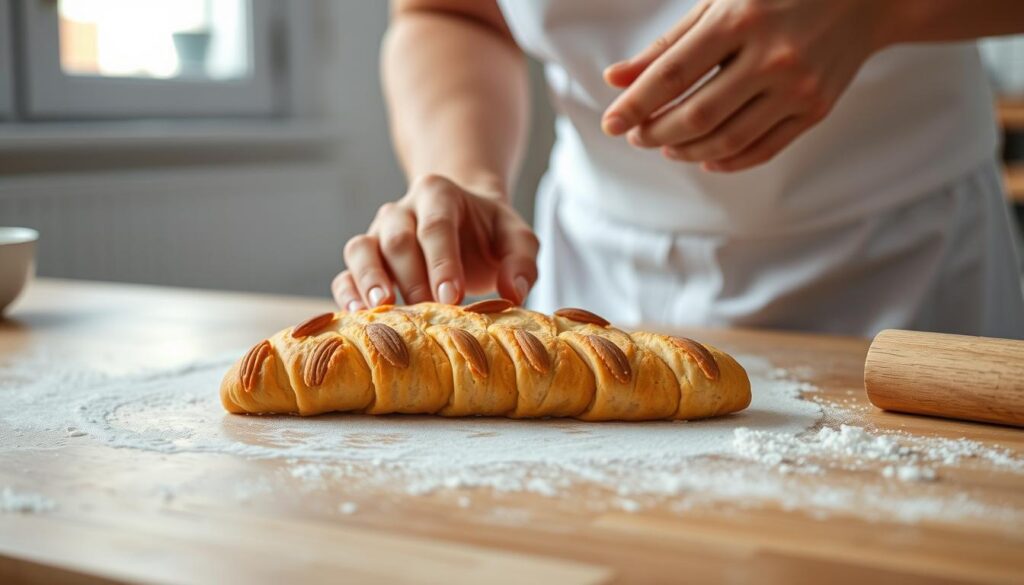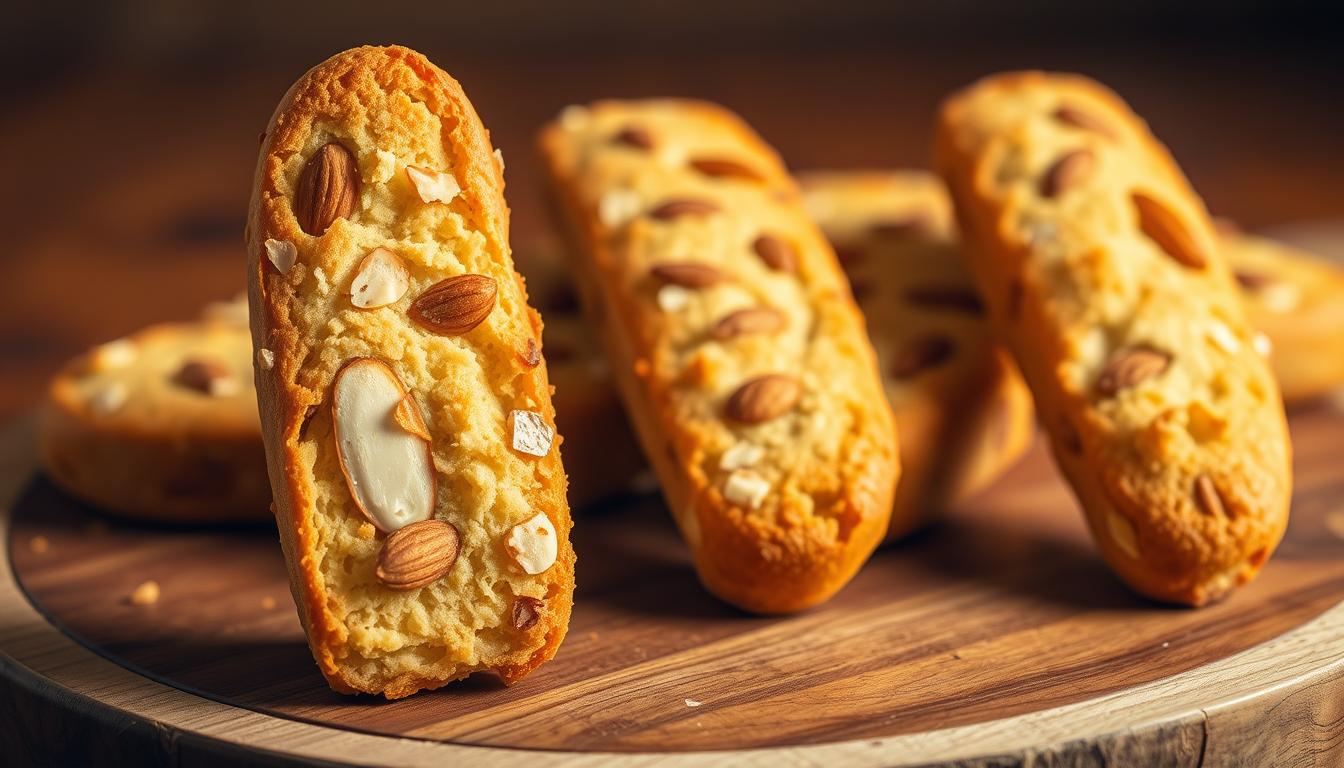Table of Contents
The first time I bit into a perfectly baked almond biscotti, magic happened. Those golden-brown Italian cookies took me to a sunny café in Tuscany. There, tradition and flavor come together in a beautiful way. Making homemade biscotti is more than a recipe; it’s a journey that connects us to our baking heritage.
Almond biscotti are more than just a snack. They carry a rich cultural heritage, turning simple ingredients into a special experience. Whether you dunk them in espresso or enjoy them as a snack, these cookies offer a delightful adventure in your kitchen.
Get ready to learn the secrets of making irresistible almond biscotti. This guide will take you through every step. You’ll learn traditional techniques and how to achieve the perfect crunch that makes these cookies famous.
Key Takeaways
- Learn authentic Italian biscotti making techniques
- Discover the art of achieving perfect crispiness
- Understand the cultural significance of almond biscotti
- Master the double-baking method
- Create professional-quality homemade biscotti
Understanding the Art of Traditional Almond Biscotti
Explore the world of traditional biscotti, a favorite Italian treat loved by cookie fans everywhere. These double-baked cookies are more than a snack. They carry a deep culinary history that spans centuries.
Biscotti have a long history, dating back to ancient Roman times. Soldiers and travelers loved these cookies for their long shelf life. The special baking method makes them stay crunchy for weeks.
Origins of Italian Biscotti Making
The word “biscotti” comes from the Latin bis coctus, meaning “twice cooked”. This unique baking method was born out of practical needs:
- Preserving food for long journeys
- Creating a non-perishable food source
- Developing a crisp texture that resists moisture
Key Characteristics of Perfect Biscotti
Making the perfect traditional biscotti requires focus on certain qualities:
- Dry and crisp texture
- Clean, sharp edges when cut
- Rich, nutty flavor
- Ability to stand up to dunking in coffee or wine
The Science Behind Double Baking
The double-baked cookies technique is more than a trick. It’s a precise way to remove moisture and achieve a crunchy texture. By baking the dough twice, you turn a soft cookie into a crunchy delight that lasts for weeks.
Grasping these details will take your biscotti from a simple cookie to a true Italian culinary delight.
Essential Ingredients for Classic Almond Biscotti
Making authentic almond biscotti begins with the right ingredients. The right choices can turn a simple recipe into a masterpiece. Knowing each ingredient’s role is key for that perfect crunch and flavor.
The base of any biscotti recipe is high-quality flour. Almond flour adds a nutty taste and boosts nutrition. Here are the main ingredients you’ll need:
- Flour Blend: A mix of all-purpose flour and almond flour for the best texture
- Fresh whole almonds for crunch and real flavor
- Pure vanilla extract
- High-quality granulated sugar
- Large eggs for binding
- Baking powder for rise
The success of your biscotti depends on the quality of ingredients. Choose fresh, top-notch ingredients. Almonds should be crisp and smell good, and flour should be stored right. Eggs should be room temperature for smooth mixing.
Professional bakers say to weigh ingredients for accuracy. Measuring cups can vary, so a digital kitchen scale is vital for consistent results.
Kitchen Tools and Equipment You’ll Need
Making delicious almond biscotti needs more than just good ingredients. The right baking tools and kitchen equipment are key to success. This guide will help you get the essential biscotti baking essentials for perfect, crispy treats.
Choosing the right kitchen equipment is vital for making professional-quality biscotti. Each tool, from mixing to baking and slicing, is important for your baking journey.
Baking Sheets and Liners
Your baking sheets are the base for making great biscotti. Here are some important items:
- Heavy-duty rimmed baking sheets for even heat
- Silicone baking mats or parchment paper for easy release
- Nonstick surfaces to prevent sticking and burning
Mixing Equipment
Good mixing is key for the perfect biscotti dough. Get reliable baking tools that make prep easier:
- Stand mixer with paddle attachment
- Large mixing bowls
- Rubber spatula for scraping sides
- Measuring cups and spoons
Cutting Tools
Accurate cutting is important for uniform biscotti that bake well. Your cutting tools should include:
- Sharp serrated knife
- Bench scraper or dough cutter
- Cutting board with a stable surface
With these kitchen equipment essentials, you’ll be ready to make delicious almond biscotti that look and taste like they were made by a pro.
Step-by-Step Mixing and Preparation Process
Making the perfect biscotti dough needs precision and attention to detail. Your mixing techniques affect the dough’s texture and quality. Begin by gathering all ingredients at room temperature for smooth mixing.
Here are the key steps for preparing biscotti dough:
- Measure ingredients accurately using a kitchen scale
- Sift dry ingredients to remove lumps
- Cream butter and sugar until light and fluffy
- Add eggs one at a time, mixing thoroughly
- Gradually incorporate dry ingredients
Getting the right dough consistency is critical. Your biscotti dough should be slightly sticky but easy to handle. Avoid overmixing, as it can make the biscotti tough.
| Mixing Stage | Key Technique | Desired Outcome |
|---|---|---|
| Creaming | Soft, room temperature butter | Light, airy texture |
| Egg Addition | Mix individually | Smooth, even mixture |
| Dry Ingredients | Fold gently | Prevent gluten development |
Pro tip: If your dough feels too sticky, refrigerate it for 30 minutes. This step helps firm up the dough, making it easier to shape during the next stages.
Mastering the First Bake: Shaping and Timing
Making the perfect almond biscotti starts with mastering the first bake. It’s all about shaping and controlling the temperature. This step is key to getting those crispy Italian cookies just right for your morning espresso.

Getting your biscotti logs to look the same takes practice. Make sure your dough is evenly formed. This ensures they bake evenly all the way through.
Proper Dough Formation Techniques
- Divide dough into equal portions using a kitchen scale
- Shape logs approximately 2-3 inches wide
- Flatten logs slightly for even baking
- Maintain consistent thickness across the entire log
Temperature Control Tips
The baking temperature is very important for a great first bake. Aim for your oven to be between 325-350°F for the best results.
| Oven Temperature | Baking Time | Expected Result |
|---|---|---|
| 325°F | 25-30 minutes | Gentle, even browning |
| 350°F | 20-25 minutes | Faster browning, crisp exterior |
Visual Cues for Doneness
Knowing when to take your biscotti out of the oven is an art. Look for these signs during the first bake:
- Golden edges with a slightly firm center
- Minimal cracking on the surface
- Logs that hold their shape when gently pressed
- Light golden color across the entire log
First bake techniques aim for the perfect mix of color, texture, and structure. You want a log that’s firm enough to slice but not too dry.
The Critical Second Bake for Perfect Crispiness
The second bake is key to making biscotti crispy and delicious. It’s what Italian bakeries are known for. This step gives the cookies their crunchy texture.
To get the perfect biscotti, follow these steps:
- Cool the first-baked logs completely before slicing
- Cut logs into uniform diagonal slices about 1/2 inch thick
- Arrange slices flat on the baking sheet
- Bake at a lower temperature to ensure even crisping
Temperature and timing are very important in the second bake. Most bakers suggest:
| Bake Stage | Temperature | Time |
|---|---|---|
| First Bake | 350°F | 25-30 minutes |
| Second Bake | 325°F | 10-15 minutes |
Try to get a golden-brown exterior and a bit of softness inside. Turn your baking sheet halfway through to crisp evenly. Be careful not to overcook, as it can make the biscotti hard or bitter.
After baking, let the cookies cool on a wire rack. This step is important for their crispy texture. It’s what makes these Italian treats so loved.
Common Mistakes to Avoid When Making Almond Biscotti
Making perfect almond biscotti needs care and focus. Troubleshooting biscotti can help fix common baking mistakes. These mistakes can affect your biscotti’s texture and taste. Knowing these issues will improve your baking and make your biscotti delicious every time.
Learning to make biscotti means knowing how to handle common problems. Let’s look at the most common mistakes and how to avoid them.
Dough Consistency Challenges
The key to great biscotti is the dough. Mistakes often start with bad mixing. This can make the dough tough and dense.
- Avoid overmixing, which can make dough tough and dense
- Ensure ingredients are at room temperature for optimal blending
- Use precise measurements to maintain ideal dough consistency
Cutting and Timing Precision
Common mistakes happen when cutting and baking the biscotti. The right technique can make your biscotti crisp and delicious.
- Cut biscotti logs while they’re warm for clean, even slices
- Use a sharp serrated knife for precise cutting
- Maintain consistent slice thickness for even baking
Storage Wisdom
Improper storage can ruin your biscotti. Here are some tips to keep your biscotti fresh:
- Store in an airtight container at room temperature
- Keep away from humidity and direct sunlight
- Consume within 1-2 weeks for optimal taste and texture
By knowing these common mistakes, you can make perfect almond biscotti. They will impress everyone you share them with.
Storing and Preserving Your Homemade Biscotti
Learning how to store biscotti is key to keeping them crunchy and flavorful. The right way to store them can make your almond biscotti last for weeks. This way, you can enjoy them at their best.
To keep your biscotti fresh, follow these important steps:
- Cool completely before storing to prevent moisture buildup
- Use airtight containers with tight-sealing lids
- Store at room temperature in a dry, cool place
- Keep away from direct sunlight and heat sources
Choosing the right storage method is important for keeping biscotti crunchy. Ceramic or glass containers with rubber seals are best for keeping air out. Plastic containers can also work, but make sure they are clean and dry first.
If your biscotti start to get soft, you can make them crunchy again. Just put them in a 300°F oven for 3-5 minutes. This trick keeps their flavor and texture perfect.
When stored right, homemade biscotti can stay fresh for up to two weeks. A tip: Add a small silica gel packet to your container. It helps keep moisture away and keeps them crunchy.
Creative Variations and Flavor Additions
Take your almond biscotti recipes to the next level. Try out different biscotti flavors to make these classic cookies exciting. They will surely delight your taste buds.
Think about adding ingredients that go well with the almond base. Some great combinations include:
- Chocolate-Dipped Almond Biscotti: Coat half the cookie in dark or white chocolate for a luxurious twist
- Citrus Zest: Add orange or lemon zest to brighten the flavor profile
- Dried Fruit Mix-Ins: Incorporate cranberries, cherries, or apricots for texture
- Spice Infusions: Experiment with cinnamon, cardamom, or nutmeg
Make your almond biscotti recipes stand out by mixing in new ingredients. Keep the classic crisp texture but add exciting flavors.
Try these variations to grow your baking skills:
- Pistachio-Chocolate Chip Biscotti
- Lavender-Almond Biscotti
- Maple-Pecan Biscotti
- Espresso-Hazelnut Biscotti
Small changes can make a big difference in your biscotti. Be bold and find your own unique cookie recipe!
Pairing and Serving Suggestions
Enhancing your almond biscotti experience is more than just baking. Italian dessert traditions show us how to make these treats unforgettable. The way you serve them can greatly improve their taste.
Traditional Italian Pairings
In Italy, biscotti are often enjoyed with Vin Santo, a sweet dessert wine. This wine matches the almond flavor perfectly. Dunking the cookies in warm espresso is also a favorite tradition. It softens the biscotti and makes their taste even better.
Modern Serving Ideas
Today, biscotti can be served in many new ways. Try making a dessert platter with your almond biscotti, dark chocolate, fresh berries, and mascarpone cream. These platters are not only beautiful but also offer different tastes and textures. They’re perfect for any gathering or dinner party.
Beverage Combinations
Don’t just stick to coffee when pairing drinks with biscotti. Try amaretto or aged bourbon in cocktails to bring out the almond flavor. For those who prefer not to drink alcohol, chai tea and herbal infusions can also enhance the biscotti’s taste.

